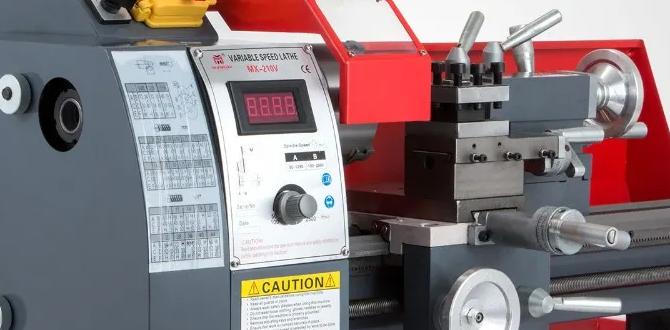Get accurate, clean cuts in wood and soft metals with a 3/16 inch 8mm shank carbide end mill, perfect for dry cutting applications. Learn how to use this versatile tool effectively for precise results in your workshop.
So, you’ve got a project that needs a clean cut, maybe in some nice plywood or even a softer metal. You’ve heard about carbide end mills, and you’re looking at a 3/16 inch diameter with an 8mm shank. Great choice! But how do you get the best results, especially when you want to cut without coolant – that’s called dry cutting? It can seem a little tricky at first, but don’t worry. This guide is all about making that 3/16 inch, 8mm shank carbide end mill your new best friend for dry cutting. We’ll walk through everything you need to know, step-by-step, so you can achieve those smooth, precise cuts you’re after.
Understanding Your 3/16 Inch 8mm Shank Carbide End Mill for Dry Cutting
When you’re working with tools, knowing what makes them tick is half the battle. A carbide end mill, particularly a 3/16 inch one with an 8mm shank, is a powerhouse for detailed work. Let’s break down why this specific tool is so useful for dry cutting.
What is a Carbide End Mill?
Carbide end mills are cutting tools used in milling machines to create a machined surface. They are made from tungsten carbide, a super-hard material. This hardness is what makes them ideal for cutting tougher materials and for dry cutting, as they can withstand the heat generated without degrading quickly. Unlike softer cutting tools, carbide holds its edge much longer and can cut faster.
Why 3/16 Inch Diameter?
The 3/16 inch (which is roughly 4.76mm) diameter is a fantastic size for a lot of common workshop tasks. It’s small enough for detailed engraving, cutting intricate patterns, or making precise slots. Yet, it’s substantial enough to handle removing material efficiently without being overly fragile. Think of it as a go-to size for many fine woodworking and light metalworking projects.
The Significance of an 8mm Shank
The 8mm shank is the part of the end mill that fits into your milling machine’s collet or chuck. An 8mm shank is a metric standard, common in many imported milling machines and CNC equipment. It offers a good balance of rigidity and compatibility. A more rigid shank means less tool flex, leading to more accurate cuts and a better surface finish.
What is “Dry Cutting”?
Dry cutting simply means performing a machining operation without the use of a cutting fluid or coolant. For many woodworking applications, dry cutting is the norm and often preferred. When working with metals, dry cutting is possible with the right tool and techniques, especially with materials like aluminum or some plastics. Carbide end mills are particularly well-suited for dry cutting because of their high heat resistance.
Benefits of Carbide for Dry Cutting
Heat Resistance: Carbide can handle the heat generated during dry machining much better than high-speed steel (HSS).
Hardness: Its superior hardness allows it to cut through tough materials efficiently.
Edge Retention: It stays sharp for longer, meaning fewer tool changes and more consistent results.
Surface Finish: When used correctly, carbide can produce exceptionally smooth surface finishes.
Applications for Your 3/16 Inch 8mm Shank Carbide End Mill
The versatility of this specific end mill makes it suitable for a wide range of projects. Whether you’re a woodworker, a metal hobbyist, or venturing into CNC, this tool can be invaluable.
Woodworking Projects
Engraving and Carving: Create intricate designs, text, or patterns in wood. The 3/16 inch size is perfect for detailed work.
Pocketing: Machining out areas of a workpiece to a certain depth, useful for inlays or creating spaces for components.
Edge Profiling: Creating decorative edges on custom furniture or signs.
Dadoes and Grooves: Making precise channels for joinery or for housing other parts.
Soft Metal and Plastic Machining
Aluminum: Machine custom brackets, enclosures, or parts for projects.
Brass: Works well for creating custom fittings or decorative elements.
Plastics: Cutting acrylic, ABS, or other common workshop plastics for prototypes or functional parts.
Wood-like Materials: Composite materials or certain engineered woods.
CNC Machining
For hobbyist CNC users, a 3/16 inch 8mm shank carbide end mill is a common and essential tool. It’s frequently used for detailed 2D and 3D carving on CNC routers and milling machines.
Essential Setup: Preparing for Dry Cutting
Before you even think about starting the cut, proper setup is crucial. This isn’t just about safety; it’s about getting clean, repeatable results.
Choosing the Right Machine
A 3/16 inch end mill is best suited for machines with a bit of power and rigidity.
Milling Machines: Traditional vertical or horizontal milling machines are ideal for metal work.
CNC Routers: For wood and plastics, a capable CNC router is perfect.
Drill Presses (with caution): While not ideal for heavy milling, some drill presses can be used for very light cuts in wood or soft materials with specialized attachments. Always ensure your drill press is sturdy and well-secured.
Securing Your Workpiece
This is non-negotiable for safety and accuracy.
Vise: A sturdy milling vise is the best option for holding metal workpieces securely. Ensure it’s properly aligned with your machine’s table.
Clamps: For wood and larger workpieces, use robust clamps. T-slot clamps, strap clamps, or toe clamps work well. Make sure clamps don’t interfere with the end mill’s path.
Double-Sided Tape (for light duty): In some very light woodworking or CNC applications, strong double-sided tape can hold thin materials. Be aware of its limitations.
Tool Holder and Collet
Collet Chuck: The best way to hold an end mill is in a quality collet chuck. For an 8mm shank, you’ll need an 8mm collet. These provide excellent runout (how true the tool spins) and a secure grip.
End Mill Holder: If your machine uses end mill holders (which grip the shank directly without a collet), ensure it’s the correct size for the 8mm shank and that it’s clean.
Setting Your Zero Point (Work Z-Zero)
This tells your machine where the top of your material is.
Manual Machines: Use a height gauge or a feeler gauge to find the exact top surface of your workpiece.
CNC Machines: Use a Z-probe, touch plate, or manually jog down until the end mill just touches the top surface. Mark this point as your Z-zero in your CAM software or machine controller.
Step-by-Step: Dry Cutting with Your 3/16 Inch End Mill
Now for the actual cutting. We’ll cover the key parameters and a safe procedure.
Feeds and Speeds: The Key to Success
Getting feeds and speeds right is crucial for a good finish, tool life, and preventing tool breakage, especially in dry cutting. This is often the most intimidating part for beginners.
Spindle Speed (RPM): This is how fast the end mill spins. For 3/16 inch carbide end mills, typical spindle speeds for wood might range from 10,000 to 24,000 RPM, depending on the machine. For aluminum, it’s often lower, perhaps 6,000 to 18,000 RPM. Always start on the lower end if unsure.
Feed Rate: This is how fast the tool moves through the material. It’s usually measured in inches per minute (IPM) or millimeters per minute (mm/min). For dry cutting in wood, you might start around 30-80 IPM (760-2000 mm/min). For aluminum, it could be similar or slightly lower, say 20-60 IPM (500-1500 mm/min).
Depth of Cut (DOC): How deep the end mill cuts in a single pass. For a 3/16 inch end mill, a conservative DOC is often around 50% of the tool diameter (approx. 0.090″ or 2.3mm). For very soft materials or light detail work, you might go shallower. Avoid taking too deep a cut, which can overload the tool and machine.
Stepover: The amount the end mill moves sideways between passes when clearing out an area (pocketing). A stepover of 30-50% of the tool diameter is common for roughing, and 10-20% for finishing.
A Note on Feeds and Speeds: These are starting points. The ideal settings depend on the specific material, the number of flutes on your end mill (2-flute end mills are common for wood and aluminum), the rigidity of your setup, and the desired finish. Always consult the end mill manufacturer’s recommendations if available. A good resource for general feeds and speeds for various materials can be found from organizations like the National Association of Manufacturers (NAM) or through tooling manufacturers’ websites.
Types of End Mills and Their Impact on Dry Cutting
The design of your end mill matters:
Number of Flutes:
2-Flute: Generally preferred for wood and aluminum. They provide good chip clearance, which is vital for dry cutting as chips need to escape to prevent overheating and premature tool wear.
4-Flute: Better for harder metals and finishing. They can handle higher feed rates but might clog more easily in softer materials if chip evacuation is poor.
Coating: Some carbide end mills have coatings (like TiN, TiAlN) that further improve heat resistance and tool life, making them excellent for dry cutting.
Geometry: Some end mills have special geometries like “chip breakers” or “sweeping” edges that are designed for better chip evacuation or smoother cutting in specific materials.
The Cutting Process: Step-by-Step
1. Install the End Mill: Securely insert the 8mm shank of your 3/16 inch carbide end mill into the collet and tighten it firmly in your machine’s spindle. Ensure it’s seated correctly.
2. Secure the Workpiece: Verify your workpiece is clamped down securely and will not move during machining.
3. Set Your Zero Point: Accurately set your X, Y, and Z zero points as described earlier.
4. Program Your Toolpath (CNC) or Plan Your Manual Moves:
CNC: Use your CAM software to define the cutting operation (pocketing, contouring, engraving). Specify the tool (3/16 inch carbide end mill), spindle speed, feed rate, depth of cut, and stepover. Consider using “climb milling” where possible for a better finish and reduced tool load, though “conventional milling” is also an option. Learn more about climb vs. conventional milling from resources like Autodesk’s Fusion 360’s help topics.
Manual: Plan your moves. For example, if engraving, you’ll hand-feed the machine precisely along your drawn or marked lines.
5. Initial Plunge: For CNC, your program will handle plunging the tool into the material. For manual operations, carefully feed the end mill down to your desired starting depth. Start the spindle before engaging the end mill with the material wherever possible.
6. Make the Cut:
Spindle On: Start the spindle at your set RPM.
Feed: Begin feeding the end mill into the material at your set feed rate. Listen to the machine.
Observe: Watch for excessive chatter (vibration), smoke (indicating too much heat or too fast a feed), or signs of the tool struggling. If any of these occur, pause the operation and re-evaluate your settings.
7. Chip Evacuation: This is critical for dry cutting. Ensure chips are being cleared away from the cutting zone. For CNC machines, this might involve clearing out chip piles with compressed air or a vacuum system if your machine isn’t equipped for it. For manual milling, you might need to pause periodically to clear chips.
8. Finishing Passes: For critical dimensions or a superior surface finish, consider making a final “finishing pass” at a shallower depth of cut and often a slightly higher feed rate. This removes residual tool marks.
9. Remove the Tool: Once the cut is complete, retract the end mill from the workpiece after stopping the spindle (or at least disengaging the feed). Carefully unclamp and remove your finished part.
Materials and Their Machining Characteristics
Understanding how different materials behave will help you adjust your approach.
Plywood
Machinability: Generally very good for dry cutting.
Chip Formation: Produces relatively large chips.
Key Considerations: Plywood can have internal voids or delaminations. Use a high-quality plywood for best results. A 2-flute end mill is excellent here due to chip clearance. A “single flute straight bit” is also a great choice for many plywood CNC operations.
Recommended Settings (General):
RPM: 16,000 – 20,000 RPM
Feed Rate: 40 – 80 IPM (1000 – 2000 mm/min)
Depth of Cut: 0.100″ – 0.250″ (2.5mm – 6.35mm) – adjust based on material thickness and rigidity.
Aluminum (e.g., 6061)
Machinability: Fairly good, but prone to “gumming up” the tool if not managed correctly.
Chip Formation: Produces small, stringy chips. This demands excellent chip evacuation.
Key Considerations: Proper feeds and speeds are vital to prevent the aluminum from sticking to the end mill flutes. Air blast or vacuum assistance is highly recommended for dry cutting. A high-quality aluminum-specific end mill (often with a higher rake angle and polished flutes) is ideal.
Recommended Settings (General):
RPM: 8,000 – 15,000 RPM
Feed Rate: 25 – 60 IPM (635 – 1500 mm/min)
Depth of Cut: 0.050″ – 0.100″ (1.27mm – 2.54mm) – shallower DOC for better results.
Plastics (e.g., Acrylic, ABS)
Machinability: Varies. Acrylic can chip easily if settings are wrong. ABS is generally more forgiving.
Chip Formation: Can produce fine chips or even melt if heat isn’t managed.
Key Considerations: Similar to aluminum, managing heat is crucial to prevent melting. Sharp, polished, and often single-flute or two-flute end mills designed for plastics are best. Compressed air is highly recommended.
Recommended Settings (General for Acrylic):
RPM: 12,000 – 18,000 RPM
Feed Rate: 30 – 60 IPM (760 – 1500 mm/min)
Depth of Cut: 0.060″ – 0.125″ (1.5mm – 3.2mm)
Considerations for Long Reach End Mills
If your 3/16 inch carbide end mill is a “long reach” version, it has an extended flute length. This is useful for reaching into deep pockets or machining parts that are recessed. However, long reach end mills are inherently less rigid than their shorter counterparts.
Reduced DOC and Feed Rates: You will likely need to significantly reduce your Depth of Cut and Feed Rate to account for the increased potential for tool deflection and vibration.
* Rigid Machine: A very rigid machine is






